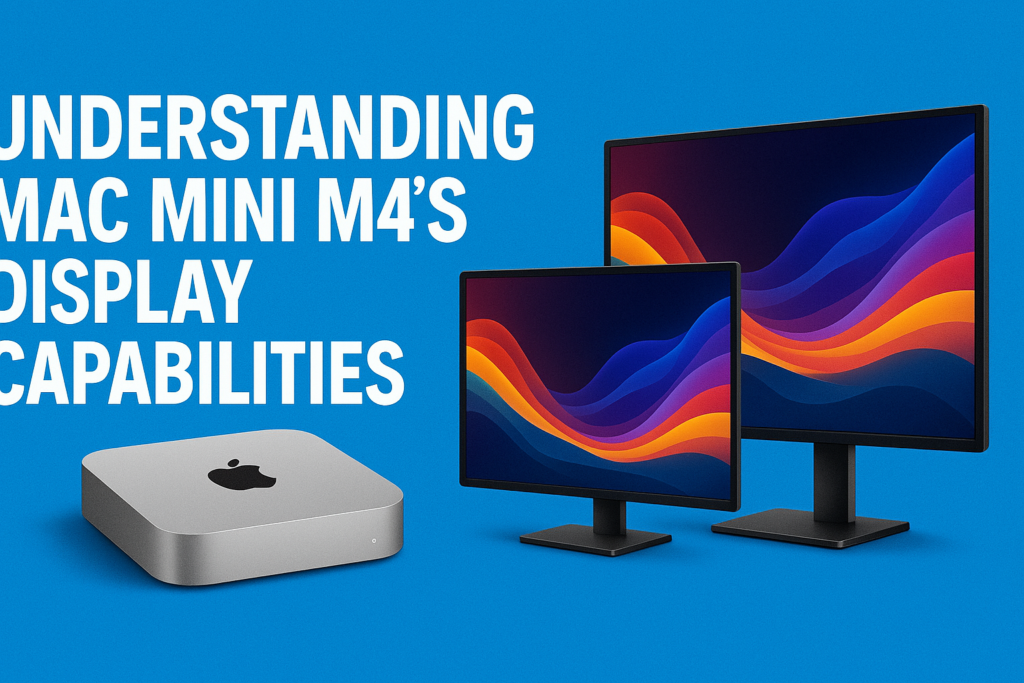The Mac Mini M4 is a powerful, compact computer that offers excellent performance for professional and personal use. However, one of the most common concerns among users is how to connect multiple monitors to maximize productivity. Whether you’re looking to set up a dual or triple monitor display, this guide will walk you through everything you need to know about connecting multiple monitors to your Mac Mini M4.
Understanding Mac Mini M4’s Display Capabilities


Before setting up multiple monitors, it’s essential to understand the Mac Mini M4’s display capabilities:
- The M4 chip supports multiple external displays, but the exact number depends on your specific configuration.
- Mac Mini M4 with base configuration supports up to two external monitors.
- Higher-end models with M4 Pro or M4 Max chips support up to three or more external monitors.
- The number of supported displays also depends on the type of connection (HDMI, Thunderbolt, or Display Port).
What You Need for a Multi-Monitor Setup
To connect multiple monitors to your Mac Mini M4, you’ll need the following:
- Compatible Monitors: Ensure they support HDMI, DisplayPort, or USB-C.
- Right Cables & Adapters: HDMI, USB-C to HDMI/DisplayPort adapters (if required).
- Powered Docking Station (Optional): Useful for handling multiple external displays.
How to Connect Two Monitors to Mac Mini M4


Using HDMI and Thunderbolt Ports
- Connect the first monitor using the built-in HDMI port.
- Connect the second monitor using a Thunderbolt (USB-C) to HDMI or DisplayPort adapter.
- Adjust Display Settings:
- Go to System Settings > Displays.
- Click on Arrange Displays to set your preferred layout.
- Adjust resolution and refresh rate for optimal performance.
Using a Docking Station
If your Mac Mini M4 supports only one external monitor natively, a Thunderbolt dock can expand the display output to support dual monitors. Look for docks that explicitly mention dual display support for macOS.
How to Connect Three Monitors to Mac Mini M4
If your Mac Mini M4 model supports three external displays, follow these steps:
- Connect the first monitor via HDMI.
- Use two Thunderbolt ports to connect additional monitors with USB-C to HDMI or DisplayPort adapters.
- Ensure DisplayLink Support: Some docks use DisplayLink technology to enable additional screens. Download the DisplayLink Manager app for macOS.
- Configure Display Settings to ensure all three monitors are recognized and properly arranged.
Common Issues & Troubleshooting
1. Mac Mini M4 Not Detecting Second Monitor
- Ensure the monitor is powered on and set to the correct input source.
- Try switching cables or using another adapter.
- Restart your Mac Mini and reset NVRAM/PRAM (hold Option + Command + P + R during boot).
2. External Display Flickering or Low Resolution
- Use high-quality HDMI or Thunderbolt cables.
- Go to System Settings > Displays and manually set resolution.
- Check for macOS updates that may include display driver improvements.
3. Docking Station Not Recognizing Additional Monitors
- Verify that your dock supports macOS multiple display output.
- Update the DisplayLink driver (if applicable).
- Restart your Mac and reconnect the dock.
Best Docking Stations & Adapters for Mac Mini M4


Recommended Docking Stations
- CalDigit TS4 Thunderbolt 4 Dock – Supports multiple monitors with high-speed connectivity.
- Belkin Thunderbolt 3 Dock Pro – Ideal for Mac Mini multi-monitor setups.
- Anker PowerExpand 11-in-1 Dock – Affordable and reliable for dual displays.
Recommended Adapters
- Apple USB-C Digital AV Multiport Adapter – Official Apple adapter for HDMI output.
- Cable Matters USB-C to HDMI Adapter – Budget-friendly choice.
- StarTech USB-C to DisplayPort Adapter – Best for high refresh rate monitors.
For specific accessory recommendations, don’t forget to check out our [Best Accessories for Mac Mini M4] guide.
Conclusion
Setting up a dual or triple monitor display with your Mac Mini M4 can significantly boost productivity. By understanding its display capabilities, choosing the right cables and adapters, and troubleshooting common issues, you can create a seamless multi-monitor workstation. Whether you’re a creative professional or a power user, expanding your screen real estate is now easier than ever.




